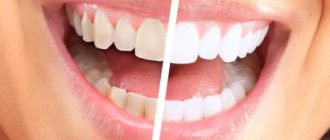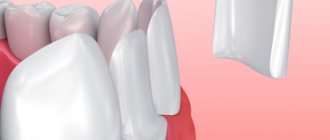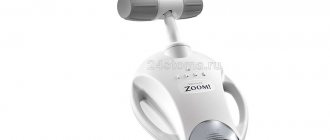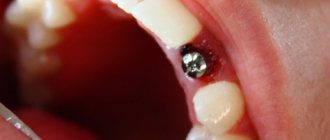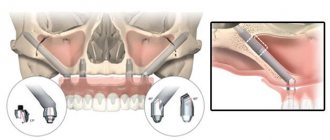There are many myths surrounding the concept of “bad bite”. Many believe that the position of teeth can only be corrected in childhood, the anomaly causes only aesthetic problems, and dental clinics only have braces at their disposal. Is it so? Let's figure it out.
Bite – the arrangement of the teeth when the jaws are closed. With a normal bite, each upper tooth is in contact with its lower “antagonist”, the dentition is even, there are no gaps.
You can correct the position of your teeth not only during the period of active growth. Of course, the easiest way to do this is in childhood. However, it is quite possible to eliminate the anomaly in adulthood. For this purpose, not only brace systems are used, but also various surgical methods, as well as microprosthetics.
It is important to understand that the success of orthodontic procedures depends on the condition of the teeth, the type of bite and the degree of pathology. The stronger the anomaly, the more difficult it will be to correct it.
In what cases is teeth straightening necessary?
Smooth and beautiful teeth are the dream of many people. After all, not everyone was given a perfect smile at birth. Dental abnormalities can be the result of poor heredity, trauma, or improper dental care in childhood. If you clearly see that your teeth are crowded, your teeth protrude greatly from the dentition, or there are other deficiencies, you should contact an orthodontist. Sometimes the problem is far-fetched, but only a specialist can determine this. A preliminary diagnosis will be made at the first appointment, and then the doctor will be able to offer treatment options.
Aligners (orthodontic aligners)
Aligners or aligners are removable orthodontic structures that are used in the treatment of adults with minor bite problems. They are made from polycarbonate using dental impressions. You need to wear the mouthguard almost constantly and only take it off when eating. The aligner applies pressure, as a result of which the bone tissue of the alveoli on the side where the tooth moves begins to dissolve. The tooth moves, and new bone tissue is formed on the side opposite to the movement. Aligners are made individually. When correcting the bite, they are changed so that the same pressure is applied to the teeth that have changed their position.
Is it possible to straighten teeth in adults?
Of course, treatment is faster in children and adolescents. This is due to the fact that up to the age of 25 in a person, the processes of bone tissue regeneration proceed faster, the ossification of bone sutures has not yet been completed, which means orthodontic treatment will be more effective. But don’t think that adults can’t be helped. Dentists have been successfully helping straighten teeth for patients of any age for a long time. It just takes a lot of time. Orthodontists typically recommend braces or aligners as options for straightening teeth in adults. In some cases, if only one or two teeth are misaligned, doctors may use veneers. These extremely thin dental coverings provide a quick solution to the problem of an imperfect smile. If the problem is several teeth and in addition the doctor diagnoses malocclusions, you will still have to use orthodontic structures.
Planning comprehensive dental treatment
A comprehensive treatment plan was drawn up jointly by orthopedic dentist S.V. Tsukor, orthodontist O.A. Baranova and neuromuscular dentist A.V. Galeev. The orthopedic dentist is the leading specialist in this treatment and coordinates the actions of the surgeon, orthodontist, neuromuscular dentist and other doctors. The goal of the treatment was to return the patient to the health of the dental system, eliminate concomitant pathologies (headaches, pain in the temporomandibular joints, apnea), and restore aesthetics.
Treatment plan:
- Removal of a wisdom tooth (tooth 1.8 - upper right)
- Hygienic preparation for orthodontic treatment
- Retreatment of the canals of tooth 1.1 (front upper tooth on the right) with a microscope
- Orthodontic treatment with neuromuscular bite adjustment
- Osteopathic support throughout the entire orthodontic treatment
- Professional dental hygiene during orthodontic treatment every 4 months
- Dental prosthetics in correct occlusion
Is it possible to straighten teeth at home?
Surely many people are interested in whether it is possible to straighten teeth at home. Don’t think that this can be done with the wave of a magic wand or using folk remedies. Teeth straightening at home means the use of aligners, trainers or elastopositioners. You will not be able to choose these designs yourself. You will need to contact an orthodontist - a doctor who straightens teeth, who will conduct an examination and tell you exactly whether removable structures will help in your case. Without a specialist, you won’t be able to cope with your problem - you shouldn’t even try. Attempting to straighten teeth without an orthodontist can lead to irreversible consequences.
Bite correction using the Invisalign system
One of the newest types of removable structures are transparent aligners of the Invisalign system.
One of the newest types of removable structures are transparent aligners of the Invisalign system . This treatment method involves manufacturing a set of special thin and transparent aligners for the patient using high-precision equipment. All mouthguards have slight differences in shape. The patient wears each one for approximately 14 days and then changes to the next one. As a result, the teeth gradually shift in the required direction, and the bite approaches normal.
How to straighten teeth for an adult?
Usually, correcting the bite and straightening the teeth is usually done in childhood. At an early age, these are removable structures, for example, trainers, lip bumpers or stretching plates; starting from the age of 10–11, braces can be installed. In some cases, you can do without braces, but the orthodontist will again tell you about this. For adults, it is more difficult to carry out the procedures. The fact is that at the age of 25, a person’s bone sutures harden, and any manipulations with the bite and other problems begin to take quite a lot of time. But this does not mean that you should give up dreams of a perfect smile. Answer to the question: “Is it possible to straighten teeth at 30 and beyond?” - of course, yes. At the first appointment, the orthodontist will tell you how to straighten teeth for an adult and what exactly to use in your case.
Correction of bite with braces
Structurally, such a system consists of arches connected by special locks - braces, fixed on the surface of the teeth.
One of the most common and effective orthodontic techniques is bite correction with a braces system. Structurally, such a system consists of arches connected by special locks - braces, fixed on the surface of the teeth. Due to the tension created by the arches, the teeth are shifted in the required direction and fixed.
Today, various braces systems are successfully used
- Metal,
- Sapphire,
- Ceramic,
- Lingual (installed on the inside of the dentition),
- Self-ligating (providing the most gentle and physiological correction of the position of the teeth).
The choice of a specific type of brace system is made individually for each patient.
What ways are there to straighten teeth?
An orthodontist straightens teeth in several ways, as we have already mentioned. Let's talk about the most popular ones. The most popular way to straighten teeth is still the use of braces. Braces vary in material, location on the teeth and the presence of a ligature. However, regardless of the type, they regularly perform their functions - treating almost all malocclusions and incorrectly positioned teeth. You can inexpensively straighten your teeth and get rid of other problems by wearing metal vestibular (located on the outside of the dentition) braces.
If braces are not an option for you, you can straighten your teeth without braces using aligners. They solve several dental problems at once - they remove gaps between teeth, correct crowding and other malocclusions. One of the most popular brands is Invisalign aligners. Mouthguards are created taking into account individual characteristics, do not break and are almost invisible when worn. You can get used to them quite quickly. On average 10 – 12 hours. However, you will need to wear such mouthguards for more than 20 hours every day. You will need to accustom yourself to this, otherwise you will not achieve a good result.
Teeth straightening devices
There are two most popular orthodontic teeth straightening systems - braces and aligners (aligners). Each has its own characteristics. Braces have been used for many decades. They differ in several parameters, for example, in material. All types of braces are equally effective. This method of treatment is time-tested. In addition, braces systems are improved every year. Even metal braces have changed and turned from creepy “brackets” into a rather neat design. In parallel with bracket systems, other technologies are also developing. Thus, several years ago Invisalign aligners became widely used. Despite the high cost, their popularity has grown in a matter of months due to the following advantages:
- are created individually for each patient, taking into account his physiological characteristics
- invisible to others
- convenient for daily use
- do not require complex care
Braces
The designs allow you to level out any, even the most complex pathologies. The device consists of the braces themselves, which are individually attached to the teeth, and an arch - under its pressure, the dentition is rearranged into the correct position. Depending on the complexity of the anomaly, you will have to wear the device from six months to two years, regularly visiting a doctor. He will record changes and adjust the system. The main disadvantage of braces is their visibility, but today there are models that provide the opportunity to hide the treatment process from others. For example, ceramic and sapphire systems are white and blend in with the enamel, and lingual braces are completely invisible because they are installed on the inner wall of the teeth.
Aligners
Another device for straightening teeth is silicone aligners. They are made from transparent material based on the patient’s personal jaw casts, so they are completely invisible on the dentition. Another advantage of aligners is that they can be removed during meals or, for example, business negotiations. Treatment with aligners does not require frequent adjustments; it is enough to visit an orthodontist once every two months. You yourself change the devices from the kit every two weeks, the doctor only monitors the process. The device must be worn at least 22 hours a day, then the first results will appear within a month.
Prosthetics
For minor crooked teeth, crowns or veneers are used. They do not correct real teeth, but only mask malocclusions, but you can see the effect immediately after installing the structures. Crowns are used if the teeth are more than half destroyed - they are ground down and dentures identical to natural teeth are put on. Veneers are fixed in the smile area and hide aesthetic defects such as chips or gaps between teeth. The structures are created individually for each patient - the specialist selects the desired color and then gives them the anatomical shape of the surface of the teeth. However, these records have one significant drawback. Which? We'll talk about this below.
Massage can speed up healing
There are several ways to make the process of correcting dental anomalies less painful. One of them is massage of the gums and palate. Experts recommend using this method during oral care procedures. Gently, without force or sudden movements, massage the gums with a medium-hard brush, performing circular movements on each jaw. This will improve blood circulation, speed up the process of straightening the teeth, reduce pain, and if repeated regularly, strengthen the gums and prevent loosening of the teeth.
Surgical teeth straightening
Is it possible to straighten teeth surgically? We can say that it is impossible to surgically correct the position of the teeth, but it is possible to change the bite. The surgical method of bite correction is used only when orthodontic treatment alone is not enough.
Surgical correction of the bite, or orthognathic surgery, is only indicated for patients with noticeable skeletal deformities that result in abnormal jaw and chin size. The operation is performed in a hospital setting under general anesthesia; the entire procedure usually takes about 6 hours. Like any other major surgery, this procedure has a recovery period. The patient will be able to return to a full life after 3 to 4 weeks. However, in any case, treatment always begins with orthodontic teeth straightening, followed by a surgical stage, after which final orthodontic correction is necessary.
Types of bite
There are several types of correct and incorrect bite.
The types of correct (physiological) bite include:
- straight;
- orthognathic;
- physiological prognathia;
- physiological opistognathia.
These types of malocclusions are widespread and do not lead to any problems with teeth or overall health.
There are more varieties of abnormal, pathological bite:
- distal. Characterized by a large sagittal fissure (from 6–9 mm). The teeth of the upper jaw protrude strongly forward. Most often, genetic predisposition is to blame for this type of bite. Possible reasons lie in the early removal of lower primary teeth, bad habits, etc.
- deep bite In this case, the front teeth of the lower and upper jaws do not touch at all - the upper jaw completely “overlaps” the lower one. Most often, such a bite occurs due to different sizes of the upper and lower front teeth, early removal of baby teeth, and bad habits.
- open bite. With this anomaly, the front or lateral teeth on the lower and upper jaws do not touch each other. The jaws do not close completely. Very often, such a bite appears due to sucking a pacifier or thumb in childhood, the habit of breathing through the mouth, and for other reasons.
- mesial. In a mesial dentoalveolar bite, the lower incisors protrude forward and the lower incisors protrude backward. With a gnathic bite, the upper jaw turns out to be smaller than it should be with a normal bite, and the lower jaw is larger.
- crossbite. In this case, the teeth on the upper and lower jaws do not match each other in size and shape, grow incorrectly, and the jaws do not close completely. Such a bite, in addition to heredity, is caused by bruxism, rapid loss of baby teeth, swallowing problems and other reasons.
- edentulous Part of the teeth (usually the lateral incisors) are missing, as a result the jaws are formed incorrectly, and the spaces between the teeth may increase. The causes of edentia have not been precisely established: these may be disturbances in embryonic development, heredity, or illnesses of the mother during pregnancy.
- crowding. This anomaly is common and is characterized by the incorrect position of the teeth on the jaws. They are located too close to each other and grow unevenly. In the past, treatment was limited to the removal of quarter premolars. Today, in 70% of cases this can be avoided.
- diastema and trema. This phenomenon is the opposite of crowding: the teeth are too sparsely spaced, there are gaps between them (three spaces - between the lateral teeth, canines, diastemas - between the front teeth).
As you can see, there are many types of pathologies, and each case requires special treatment.
In what cases is grinding necessary?
As we have already said, veneers are used to correct minor defects in the dentition - for example, chipped teeth, curvature of one or two teeth, as well as diastema. The main disadvantage of this method is the grinding of dental tissue to remove all irregularities. In addition, if you do not prepare your teeth before installing veneers, then after prosthetics they will look too convex and unnatural.
The structures themselves will last about ten years, after which they must be replaced with new ones, since turning teeth is an irreversible process.
Important!
To fix the veneers, the patient’s teeth are ground down by approximately 0.3 - 0.7 mm.
Preparation for orthodontic treatment
Before fixing the braces, the patient visited surgeon V.P. Alaverdov for the removal of a failed wisdom tooth.
Commentary by surgeon V.P. Alaverdova: “After the initial consultation with S.V. Zukor and subsequent comprehensive consultation with specialists, the patient was referred to me, and I carried out the first stage of the approved treatment plan. 1.8 tooth was removed. When removing a wisdom tooth, atraumatic techniques were used to preserve bone and gums. Two hemostatic sponges were placed in the socket and laser biostimulation was performed. The action of laser radiation sterilizes the hole, preventing possible complications and accelerating tissue healing. The removal was successful, healing without complications.”
Hygienist E.P. Smirnova performed Air Flow teeth cleaning, ultrasonic tartar removal, and minor gum treatment. This stage is performed free of charge as part of a promotion for patients undergoing complex orthodontic treatment.
The endodontist treated tooth 1.1 (front upper tooth on the right). Treatment of tooth canals, as well as placement of fillings, is performed using a dental microscope. Root canal treatment uses high-tech instruments to penetrate the crooked, narrow canals of teeth and provide the most thorough treatment possible. Treatment of canals under a microscope provides a full guarantee of quality and a long-term prognosis, which is important when installing expensive denture structures.
How do teeth become straight?
After the patient has been fitted with braces or has started treatment with aligners, the process of teeth straightening begins. The constant slight impact of the orthodontic system leads to the fact that the bone around the tooth changes: on the one hand it increases, and on the other it decreases. And the tooth moves to the desired point. It is important that the load is not excessive or insufficient - in either case, the treatment will not lead to the desired result. But an experienced orthodontist will not allow this to happen. It is to regulate the process of teeth straightening that you need to regularly visit your doctor. Treatment will last 1.5 – 2 years. After this, you will have to wear retainers for some time to fix the result.
Dental prosthetics
Orthopedic doctor S.V. Zukor performed diagnostic impressions and diagnostic prototyping. At the same stage, temporary plastic crowns were made, which were installed on the patient’s teeth after their preparation.
In our own dental laboratory “Dial-Dent”, dental technician D.V. Wolf made the ceramic restorations. For each tooth there is an individual restoration (crown, veneer, inlay).
Commentary by dental technician D.V. Volka: “Nice, nice patient! Very interesting, challenging work! I applied my maximum skills and positive mood to make the work work out. In this case, a team approach and proper planning of all stages of prosthetics played a big role in obtaining an excellent result. E.max press was used to fabricate the restorations. The shape and color were discussed with the patient at the wax-up fitting stage to avoid errors in the desired result.”
Ceramic restorations on the model, E.max ceramics:
Final dental prosthetics were performed using special onlays, crowns, and veneers made for each tooth separately. A ceramic restoration recreates the correct shape of the tooth, which is important for the appearance of the teeth and for function.
After placement of the permanent restorations, the patient underwent a final occlusion assessment by a neuromuscular dentist. The patient noted an improvement in his condition, the absence of headaches, and discomfort in the temporal joints. In addition to the patient’s subjective sensations, the doctor focuses on a computer analysis of the functioning of muscles and joints. Below are diagrams obtained during neuromuscular diagnostics after treatment.
Myography at rest after prosthetics. The work of the temporal, chewing and sublingual muscles is balanced. The lower jaw is in a neutral position, that is, in the comfort zone.
Load myography after prosthetics. The condition of the masticatory and temporal muscles is normalized, the excess load is removed.
Axiography of the movement of the lower jaw after prosthetics. The trajectory of the lower jaw has been restored. After neuromuscular correction and adequate prosthetics, the patient’s headaches and pain in the temporal joints completely disappeared, as rotation in the first three cervical vertebrae was eliminated and the functioning of the temporomandibular joints was normalized.
How to straighten your front teeth?
In some cases, the dentition has slight deficiencies, for example with the front teeth. The orthodontist will tell you how to straighten your front teeth. He may recommend getting braces or treatment with aligners. However, sometimes cosmetic dentistry can help straighten the two front teeth. If there are no bite defects, you should consult an orthopedist - a doctor who specializes in prosthetics. He can offer the option of installing a veneer - an overlay 0.5 - 0.7 mm wide, which allows you to make your smile perfect. This technology has its pros and cons. An undoubted advantage is the speed with which the installation is carried out - just a few days, and the problem is solved. Here's a way to quickly straighten your teeth. Another plus is the service life. One of the disadvantages is the need to grind the tooth, and this is an irreversible process. In the same way, you can straighten 1 tooth, and not necessarily the front one. Sometimes an orthodontist suggests straightening the lower teeth without using braces or aligners and using veneers or lumineers. In each specific case, consultation with a doctor is necessary.
Who is alignment indicated for and why is it needed?
The need for leveling arises in the following situations:
- crooked teeth or incorrect position in the dentition: for example, if they are rotated, crowded, grown higher or lower than others,
- incorrect bite, i.e. the dental rows close pathologically: for example, distal - the upper row protrudes strongly forward, or mesial - the lower row protrudes in front of the upper (which should not be the case), cross, open and deep bite,
- displacement of adjacent teeth towards the “hole” remaining in the place of the removed one: correction here is needed for further prosthetics or implantation,
- erased enamel on the crowns, due to which their height has decreased (and it may decrease unevenly on adjacent crowns).
Any pathology of the bite or curvature is not only an external problem, but also a functional one. If the teeth do not align or fit together correctly, it becomes difficult to chew food, pain and unsteadiness appear, stone accumulates in the contact areas and interdental and cervical caries appears. The later a person begins to correct the situation, the more problems dentists discover in the oral cavity - but everything can be solved.
Where can I straighten my teeth and how long will it take?
It is better to choose a dental clinic for bite correction carefully. Ask your friends and acquaintances if they can recommend where to straighten your teeth. Get acquainted with clinic websites and reviews of doctors’ work. A little research will save you from possible disappointment. An extremely low price should alert you: in such cases, the clinic probably simply does not indicate the cost of additional procedures.
The duration of treatment and price depend on the diagnosis made by the orthodontist. Usually, the doctor can immediately determine exactly in what period it will be possible to straighten the teeth and how much time it will take. Usually, on average, it takes 1.5 – 2 years to straighten teeth with braces. It is impossible to say which braces straighten teeth faster. All braces are effective. Except that with plastic braces, treatment may take longer - they break, and the doctor has to replace parts of the structure, and this delays the treatment time. If you only need to fix one or two teeth and you decide to get veneers, the entire treatment is unlikely to take more than 2 weeks.
There are many ways to straighten your teeth. You just have to decide to change your smile, and after a while you will definitely achieve it. The question of whether teeth need to be straightened should not even arise. Of course you need it! With a beautiful smile, most likely, your attitude towards yourself and the world will change for the better!
In the modern world, teeth straightening is a standard procedure that millions of people of different ages undergo. The fact is that a beautiful smile is not only the key to personal success, but also a means of maintaining health. Some dental abnormalities can cause diseases of various body systems. If you are looking after your health, you should not ignore the presence of dental anomalies. Straightening your teeth and making your smile perfect is not so difficult, and the result will delight you for the rest of your life!
Bite after wisdom tooth removal
Some doctors are convinced that wisdom teeth are an atavism and must be gotten rid of. In ancient times, they were used to chew tough foods, such as raw meat. With the development of civilization, the human diet changed, his jaw began to gradually decrease - and the “eights” turned out to be superfluous. Most often, before starting to correct the bite, wisdom teeth are removed. This frees up space for the correct formation of rows, and the result of teeth alignment will be much better.

